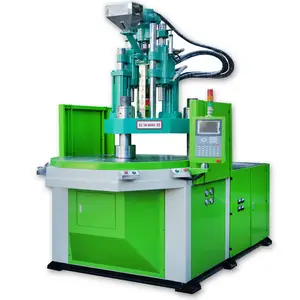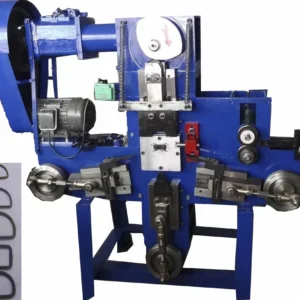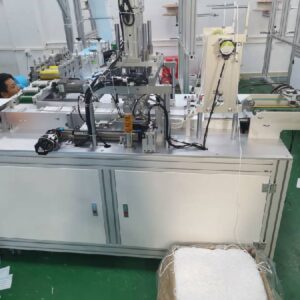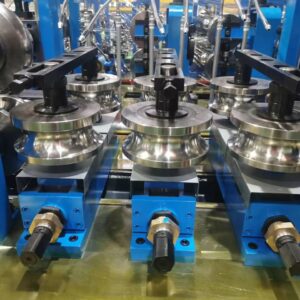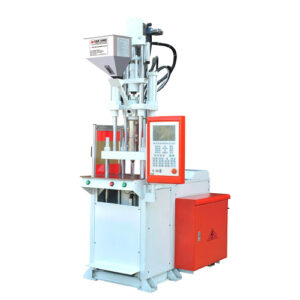Description
| Specification | Details |
|---|---|
| Machine Type | Automatic Injection Molding Machine |
| Capacity | 1000 pieces/hour |
| Material Compatibility | Plastic (Polypropylene, PVC, ABS, etc.) |
| Mold Types | Single or Multi-Cavity |
| Injection Pressure | 100-300 MPa |
| Injection Speed | 100-500 mm/s |
| Clamping Force | 50-200 tons |
| Heating System | Electric (PID controlled) |
| Control System | PLC with Touchscreen Interface |
| Power Requirements | 3-phase, 380V, 50Hz |
| Machine Dimensions | 3.5m x 2.0m x 2.5m (L x W x H) |
| Weight | 4-6 tons |
| Safety Features | Emergency Stop, Safety Light Curtains, etc. |
| Warranty | 1-year limited warranty |
Introduction to Accessories Making Machines
The modern manufacturing world is reliant on accessories-making machines as these facilitate the production of a wide range of essential accessories used in different industries. These machines are responsible for ensuring that buttons, zippers, buckles, and eyelets can be produced in large numbers to streamline the production processes and ensure efficiency, accuracy, and consistency. By combining sophisticated automation systems with precision engineering and advanced technology, the process of making accessories has been transformed by introducing these machines that have subsequently allowed producers to adapt to changing market needs.
These machines play significant roles in the garment-making industry, footwear manufacturers, bag and luggage fabricators automotive upholstery, and home furnishing. They are flexible and hence can produce accessory items made from different materials in different sizes and designs to match customers’ preferences as well as meet industry requirements.
As manufacturing processes continue evolving while demand for customized high-quality accessories surges; accessible machines remain must-have tools giving manufacturers an edge over their counterparts in the highly fluctuating global marketplace. In this section we will look at types, how they work, applications, functions, features operation as well as the importance of these equipments amidst entire manufacturing.
Types of Accessories Making Machines
Accessories-making machines include numerous pieces of equipment aimed at producing various kinds of small items like:
Button-Making Machines: They help create buttons using various materials such as plastic metals or cloth-wrapped ones.
Zipper-Making Machines: The zipper-making machine creates zippers which are important parts found on garments or bags among others.
Buckle-Making Machines: As its name suggests this type manufactures buckles that are later used in belt bags and shoes among other things. Such instruments manufacture buckles that differ in dimensions and forms.
Eyelet and Grommet Machines: These devices aid in installing eyelets or grommets within fabrics such as clothes and leather paper by providing hole reinforcement besides neat completion along the same line.
Rivet Setting Machines: Rivet setting machines provide a means of securely attaching rivets into fabrics and other materials thereby making jeans bags and shoes, for instance, more durable and attractive.
Snap Fastener Machines: This type is used to fasten snap fasteners namely press studs to clothes worn by children, bags, or anything that requires quick attachment.
Working Process of Accessories Making Machines
However, there are specific working processes involved depending on the machine type; the general principles are consistent among the majority of accessories-making machines. These processes consist of:
Material Preparation: The machine feeds on raw materials like plastic pellets metal sheets or fabric strips.
Molding/ Forming: during this stage, the machine reshapes the raw materials into accessory components like buttons zippers buckle eyelets, etc. via molding stamping or other forming methods.
Assembly (if applicable): There could be instances where some devices employ joint involving several parts being brought together so that it becomes one complete accessory item at last.
Finishing: After formation and assembly processes have been completed, these items may undergo final stages such as polishing coating painting, etc to improve their visual appeal and lifespan.
Quality Control: Quality control is implemented throughout the entire process of manufacturing to ensure that dimensions strength and aesthetics among others meet specifications for different jewelry accessories imposed.
Accessories Making Machines in the Manufacturing Industry
Garment Industry: Clothing production needs accessories-making machines because these are the essential components that make up a garment such as buttons, zippers, buckles, and other accouterments.
Footwear Industry: A high demand for an accessory machine in the shoe manufacturing industry is driven by shoe buckles, eyelets, rivets, and snap fasteners which are typically used.
Bags and Luggage Industry: This sector uses accessories-making machines to produce bags, backpacks, and luggage that have zippers, buckles, rivets, and other items that make them functional or fashionable.
Automotive Industry: Fasteners like seat belt buckles and zipper pulls are made by using accessories-making machines to cater for automotive interior upholstery among others.
Home Furnishing Industry: In this industry curtains cushions and upholstery need such things as button eyelets zips etc. to work properly or to add beauty when required thus requiring accessories-making machines.
Functions And Features Of Accessories Making Machines
Despite differing in type and intended application, the functions and features of accessories-making machines have similarities such as:
Precision Manufacturing: Uniformity of size shape and quality is achieved with precision in their sizes using accessories-making machines that deliver accurate results every time.
Versatility: Flexibility for manufacturers in producing various types of accessories is offered by many accessories-making machines that can handle different materials dimensions and designs.
High-Speed Production: Modern-day automation enhances the speed of new models of these devices hence they can perform faster enabling mass manufacturing requirements to be met promptly
Ease Of Operation: Intuitive controls plus user-friendly interfaces ensure easy operating procedures that minimize errors; hence one does not require extensive training to use it.
Customization Options: These equipment have adjustable settings within its tooling capabilities thus enabling manufacturers to fit into specific production processes accordingly based on any orders given or demands put forward.
Quality Assurance: During the production process some built-in systems and mechanisms for monitoring help to detect and rectify any defects thus ensuring only top-quality accessories are made.
How To Operate Accessories Making Machines
The process of operating an accessories-making machine typically involves:
Setup: Make sure that the equipment is at its best calibration, and that all necessary tooling and materials are ready.
Material Loading: According to the manufacturer’s instructions, feed the machine with input material like plastic granules, metal sheets, or fabric strips through its feed mechanism.
Adjust Settings (if necessary): For specific production conditions alter parameters such as temperature, pressure, or speed.
Start The Machine: Use a panel or switch to begin using it while checking on how well it works throughout the whole time.
Feed Material Continuously: Avoid stopping the flow of raw materials into the feeding mechanism so as not to interrupt the production process
Monitor Output: Keep track of the quality and output of produced accessories by conducting periodic checks that can enable one to identify any problem if there is any immediately thereby fixing it promptly.
Shutdown Procedure: In line with the manufacturer’s directions take some steps to safely shut down a machine after use including their maintenance or cleaning where applicable either at the end of a run or otherwise.
Roles Of Accessories Making Machines
Accessories-making machines perform key roles in the manufacturing industry such as;
Enhancing Efficiency: These machines increase production efficiency by automation and streamlining processes reducing labor cost and lead times.
Ensuring Consistency: Compared to manual methods these machines produce similar products because they have the same specifications which maintain consistent quality hence reducing variations or defects.
Enabling Innovation: Manufacturers can use accessories-making machines to explore new designs with different materials and manufacturing techniques, which promotes innovation in the market.
Meeting Market Demand: These machines help to meet the market demand for products by producing accessories on a large scale at high speeds.
Improving Product Quality: Accessories-making machines have precision engineering as well as quality control measures that ensure the production of high-quality accessories above customers’ expectations.
FAQs (Frequently Asked Questions)
What precautions should be taken when operating an accessories-making machine?
This includes wearing proper personal protective equipment like gloves and safety glasses, avoiding loose clothing or jewelry, and following manufacturer-provided guidelines specific to the machine.
Is it possible to customize an accessory-making machine so that we can produce unique designs?
Yes, several accessory-making machines have customization options based on adjustable settings for individual parts or tooling interchanges that enable diverse design ranges
How do I maintain my accessory-making machine for optimum performance?
To guarantee optimal performance and prolong the life of accessory-making machines, one must perform regular maintenance such as cleaning, lubrication, and inspection of components occasionally.
Can these machines be used in small-scale production of accessories?
There are various sizes and capacities of accessories-making machines suited for both small-scale and massive production volumes.
What challenges does one face when running an accessory-making machine?
Challenges may include material jams, tool wear outages, machine glitches, or poor quality control. This has common solutions such as routine servicing or proper training of staff.
Do they fall under the category of being eco-friendly?
Most modernized accessory manufacturing units are made to conserve the environment through waste reduction as well as power-saving technologies in their operations.
Do these tools handle different kinds of materials like metal or plastic?
Yes, depending on the nature of the machine in question this means among other things that leather fabric metal plastic, etc can all pass through them
In selecting an appropriate accessories-making machine what criteria should be considered?
These include production volume, desired output quality, material compatibility, space availability, budgetary limitations, and after-sales service from the manufacturer.
Do you require any specialized training to operate accessories-making machines?
However, some machines may need extra skills in terms of setup and maintenance other than basic operational training. Such training programs are often provided by manufacturers.
Can these be integrated into existing production lines?
Yes, with proper planning and coordination during the installation process, accessory-making devices can be fully absorbed into the running of the production system.

